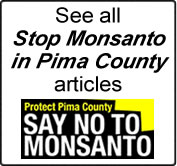Eating Clean: How to Avoid Gluten
and GMOs
by Melissa Diane Smith
With mounting scientific evidence linking serious health concerns to GMOs – including the results last year of the first long-term animal study that found tumors and organ damage in rats that ate herbicide-resistant genetically modified corn – more and more people are shunning genetically modified foods.
If you already eat gluten free, how do you avoid both gluten and GMOs? Try these tips:
- Emphasize fresh produce. The vast majority of fresh vegetables and fruits are not genetically modified. Those that are – or can be – are zucchini, yellow squash, corn, and papaya from Hawaii and China. Avoid those four foods, or seek out organically grown versions of those foods – and eat other types of vegetables and fruits freely.
- Avoid the 3 Cs and 2 Ss. Read food labels of gluten-free products and watch out for the 3 Cs – canola oil, cottonseed oil, and corn in its many different forms – and the 2 Ss – soybeans and sugar* derived from sugar beets. These five crops are the most common genetically modified foods and should be avoided unless they are specifically labeled organic or non-GMO.
- Look for organic or Non-GMO Verified, gluten-free packaged foods. Products that carry USDA Organic seal are produced according to regulations that prohibit the use of GMOs, prohibit co-mingling or contamination during processing and handling, and require preventative practices to avoid contact with GMOs. Products that have the Non-GMO Project Seal on them are independently verified to be in compliance with North America’s only third party standard for GMO avoidance, including testing of at-risk ingredients. For extra insurance, seek out gluten-free products that contain both the USDA Organic and Non-GMO Project Verified seals. Some examples include: Lundberg Family Farms rice products; Silver Hills Gluten Free Omega Flax and Chia Chia Bread; Mary’s Gone Crackers Sticks & Twigs, crackers and cookies; Hail Merry snacks and desserts; Go Raw cookies, bars, and sprouted seeds; Nutiva organic coconut products and seeds; Coconut Secret soy sauce substitute, sweeteners, bars, and frozen desserts; Choice Organic Teas; and gluten-free versions of both Pacific and Amy’s Organic Soups.
- Be choosy about the oils you use. Steer clear of GM vegetable oils: soybean, corn, canola, and cottonseed oils. Try organic virgin coconut oil or unrefined sesame oil in cooking, and extra virgin olive oil in salad dressings.
- Upgrade the animal products you eat. As of right now, there is no genetically modified fish, fowl, or livestock approved for human consumption. However, to avoid secondhand sources of GMOs – in other words, products from animals raised on GM feed such as grains – search for organic products, and those from wild caught fish or game, and 100% grass-fed animals. Get to know local meat purveyors in your area and ask questions at you’re the butcher’s counter. Also, look for Non-GMO Project Verified animal products, including Mary’s Organic Turkey, Non-GMO Free Range Chicken, and Pasture Raised Chicken; Mindful Meats grass-fed beef products; Rumiano Organic Cheeses; and NatureFed Eggs.
- Go to my Eat GMO-Free Challenge for additional tips. For personalized help taking GMOs out of your diet, contact me for nutrition counseling or coaching.
*Note about sugar: Unless labeled otherwise, products that contain “sugar” in their ingredients almost always contain a mixture of sugar from sugar cane and GM beet sugar.
Keep in mind that whether GMO or not, there are important health reasons to avoid or greatly limit sugar in your diet. See my Syndrome X book or this post for more info.
Copyright © 2013 Melissa Diane Smith
